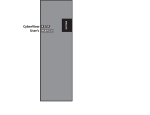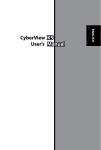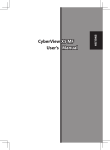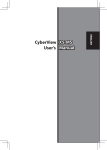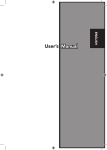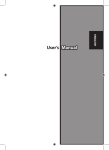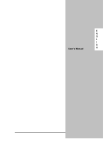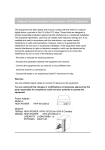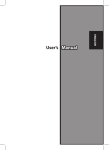Download Reflecta CyberView X5 MF User`s manual
Transcript
ENGLISH ENGLISH CyberView X5 MF User’s Manual 1 FEDERAL COMMUNICATIONS COMMISSION (FCC) STATEMENT ENGLISH This Equipment has been tested and found to comply with the limits for a class B digital device, pursuant to Part 15 of the FCC rules. These limits are designed to provide reasonable protection against harmful interference in a residential installation. This equipment generates uses and can radiate radio frequency energy and, if not installed and used in accordance with the instructions, may cause harmful interference to radio communications. However, there is no guarantee that interference will not occur in a particular installation. If this equipment does cause harmful interference to radio or television reception, which can be determined by turning the equipment off and on, the user is encouraged to try to correct the interference by one or more of the following measures: • Re-orient or relocate the receiving antenna. • Increase the separation between the equipment and receiver. • Connect the equipment into an outlet on a circuit different fromwhich the receiver is connected to. • Consult the dealer or an experienced radio/TV technician for help. Warning : Use only shielded signal cables to connect I/O devices to this equipment. You are cautioned that changes or modifications not expressly approved by the party responsible for compliance could void your authority to operate the equipment. 2 TABLE OF CONTENS ENGLISH Getting Started 4 Quick Installation Guide (QIG)6 Installing Software and Driver 6 Installing Hardware 8 Inserting 35mm Slides 8 Inserting 35mm Film strips 9 Additional Features 10 One Button Scan 10 How to Scan Slides 11 STEP 1 - Aquire Driver 11 STEP 2- Select Film Type 11 STEP 3 - Optional Prescan 11 STEP 4 - Set Scan Settings 11 STEP 5 - Set Scan Preferences 13 STEP 6 - Scan 16 STEP 7 - Exit 16 User Interface 17 I Main Window Area 17 II Preview Window Area 22 III Active Frame Setting Area 24 IV Thumbnail Panel Area 25 Technical Support 26 3 GETTING STARTED ENGLISH Check the package content before getting started. For Quick Installation please refer to Quick Installation Guide. (Ref. Pg. 11) Important! Save the original box, receipt and packing material for future shipping needs. Package Contents • Film Scanner. • Power Adapter [Model: A2-36SG12R-V] Warning! Using any other power adapter may severely damage the scanner and will void the product warranty. • USB 2.0 Cable. • CyberView Driver CD • Application software CD for scan editing. • Printed User’s Manual. NOTE: • Application software means the imaging software such as Adobe® Photoshop® Elements, this is subject to change without notice. • GENERAL GUIDANCE: • Only use the supplied USB-Cable. Connect the computer to the scanner directly using the USB 2.0 cable. • Do not use a Hub or extension cable. Only use the USB ports on the rear of desktop computers. • If there are any other devices (multifunction device, printers, scanners, webcam) connected to the computer through USB disconnect them. • A minimum of 1GB RAM (Windows/Mac) is required. 4 Operating Ambient Temperature Range 50º to 104ºF (10º to 40ºC) Note: Do not turn on the scanner unless it is within this range. If the scanner has been stored or transported outside of this range, allow it to return to within this range before turning it on. ENGLISH Operating Ambient Humidity Range 15% to 76% relative humidity (non-condensing) Note: If the scanner is stored or to be transported in cold temperature and then brought into a warm / humid environment condensation may occur. This device is designed solely for private use and is not intended for commercial use. The warranty is reduced from 2 years to 1 year if errors or defects arising from inappropriate use, improper operation or stress occur. The guarantee period of the device for private use is 2 years or 20,000 scans. 5 QUICK INSTALLATION GUIDE (QIG) ENGLISH WINDOWS SYSTEMS INSTALLATION DURING DRIVER INSTALLATION A WARNING DIALOGUE BOX MAY APPEAR, IF THIS IS THE CASE PLEASE SELECT “INSTALL THIS DRIVER ANYWAYS”. Be sure to install the Application Software BEFORE installing the scanner driver CyberView You may install the scanner driver directly if you have already installed TWAIN compliant application software in your computer. Mac users can use iPhoto for editing. Notice: 1. In “Found New Hardware Wizard” window, select “Search automatically or Browse computer for driver software.” 2. In “Completing the Found New Hardware Wizard” window, click “Finish”. NOTE: Not all PC’s will display the found new hardware window, some will install in the background INSTALLING SOFTWARE AND DRIVER Before Installing the Scanner Driver... If you choose to use the provided application for image editing, install the application software (ex: Adobe® Photoshop® Elements) by inserting the application CD into the computer’s CD/DVD drive. Follow the instructions that will be displayed in a window that opens automatically. Installing Scanner Driver a. Insert driver CD into the computer CD/DVD drive and explore the contents. b. Double click the ”CyberView” icon to begin the installation process. Follow the onscreen prompts to complete the installation process. NOTE: Make sure the scanner is NOT connected to the computer during the CyberView X 5.0 driver installation. c. Restart computer once the installation process is complete. Please Note: When installing your new scanner onto a Windows system that already has another USB Flatbed scanner or All-in-one Scan/Copier/Printer device installed, it may be necessary for you to disconnect the other scanner from the USB port for the Film scanner to work properly, 6 TWAIN scanner plug-in Installation Guide for Adobe Photoshop Elements 9 and newer versions ENGLISH The TWAIN scanner plug-in is no longer installed with Photoshop Elements 9. In order to be able to import scanner device through Adobe Photoshop elements, please follow below instructions after installing Adobe Photoshop Elements 9 to find where and how to install the TWAIN component which was previously installed with the application for versions earlier than Photoshop Elements 9. Important: Do not move plug-ins from previous versions of Photoshop Elements into the Photoshop Elements 9 > Plug-Ins folder, or set the Photoshop Elements 8 (or earlier) > Plug-In folder as the Additional Plug-Ins Folder in Preferences. Find complete information at official Adobe website: http://kb2.adobe.com/cps/849/cpsid_84933.html Macintosh To install the legacy TWAIN plug-in for Macintosh, copy TWAIN.plugin folder from: //Applications/Adobe Photoshop Elements 9/Optional Plug-Ins/ ImportModules/ Into: //Applications/Adobe Photoshop Elements 9/Locales/<locale>/Plug-Ins/ Windows To install the legacy TWAIN plug-in for Windows, copy twain_32.8ba from: C:\Program Files\Adobe\Photoshop Elements 9\Optional Plug-Ins\ImportExport\ Into: C:\Program Files\Adobe\Photoshop Elements 9\Locales\<locale>\Plug-Ins\ Import-Export\ 64-bit Windows Photoshop Elements 9 is a 32-bit application. When installed on a 64-bit version of Windows the path is slightly modified. To install the legacy TWAIN plug-in for Windows, copy twain_32.8ba from: C:\Program Files (x86)\Adobe\Photoshop Elements 9\Optional Plug-Ins\ImportExport\ Into: C:\Program Files (x86)\Adobe\Photoshop Elements 9\Locales\<locale>\ Plug-Ins\Import-Export\ 7 Installing Hardware Connect the slide scanner to a power source. ENGLISH Off 1. Locate the power switch on the lower right side of the scanner. Make sure the scanner is TURNED OFF. On 2. Plug the AC adapter into an AC power source FIRST before plugging it into the scanner. 3. Attach the USB cable to the computer using the stadard USB adapter end. Attach the USB adapter end of the cable to back panel of the scanner. Inserting Mounted Slides Attention Before Scanning… Make sure there is no filmstrip inside scanner before you insert the slide and there is no slide inside scanner before you insert the filmstrip. Please note the slide and filmstrip cannot be put into the scanner at the same time. Mounted Slides 1. 8 Insert the slide into the slot on the front of the unit, with the dull (emulsion) side facing up Inserting Mounted Slides (Continued...) 2. Set Scan settings and preferences See Page 13 3. See Scanning options on page 12 No slide detected ENGLISH Note: Some slide mounts are thin and will require you to apply gentle pressure to the edge of the mount after insertion for it to register in the scanner, you will know it is detected by the Preview bar in the user interface, the icons will illuminate in color slide detected Inserting Filmstrips 1. Insert the filmstrip with emulsion side up from the left film entrance. 2. Scanner will auto load and position the first frame in the center of the viewing window, if the first frame is not at the correct position, please move it by clicking “FORWARD“ or “REVERSE“ button and you can also move it via the fine tuning function in CyberView interface. See Page 24 3. See Scanning options on page 12 You can load the film easily by holding around the 3rd frame of the filmstrip 9 Additional features Buttons on the scanner ENGLISH Eject - Ejects the Film strip Reverse - Reverses the strip one frame Forward - Advances the film one frame Scan - See One Button Scanning below REVERSE FORWARD VIEWING WINDOW One Button Scan 1. Open the CyberView (see page 11 to acquire the CyberView driver program) 2. Configure Scan Settings (see Page 12) 3. Select the Scan to directory, file format (TIF or JPG, once configured, Press the scanner button ( ) to begin scanning. One Touch Button NOTE: If you do not open CyberView FIRST, the scan button will not function. 10 HOW TO SCAN SLIDES STEP 1 – Acquire Driver ENGLISH (For PC User) Open CyberView from Start – All Programs –CyberView (For MAC User) Open Macintosh Hard drive – Applications –CyberView STEP 2 – Select Film Type Select the film type to be scanned - Positive, Negative or B&W (Black and White). STEP 3 – Optional Prescan Select the “Prescan Current Frame“ to prescan the slide currently loaded into the scanner or “Prescan All..“ to prescan an entire negative strip Pre-Scanning should be used to manually adjust color/edit settings for each slide before doing the final scan. It’s possible to set different settings for each slide to be scanned. STEP 4 – Set Scan Settings a. Resolution The default scanning resolution is 1000dpi, additional resolution options are listed below. 11 Set Scan Settings (Continued...) Notice: Higher scanning resolutions result in greater scanning time and hardisk space requirements. ENGLISH b. Color Depth Choose between 8 and 16bit. A higher color depth setting will result in a larger range of colors in the final scanned image. The Film Scanner color depth is 48 bit true color. The scanning software has the capability of selecting 8 bit color mode or 16 bit color mode when scanning, This will produce 24 or 48 bit color images, 8 bits or 16 bits per Red, Green and Blue color channels. Example: 8 bit mode = 8 Red, 8 Green, and 8 Blue for a total of 24 bit color 16 bit mode = 16 Red, 16 Green, and 16 Blue for a total of 48 bit color NOTE: Make sure there is enough space available on the computer when changing the Scanning Resolution. A high scanning resolution results in large files that may prove difficult to save. Color image file size of different resolutions and color depths: Scanning Resolution Color Depth (by RGB Color Mode File Size TIFF 300dpi 8 bit 24-bit ~350Kb (no compression) channel) 600dpi 8 bit 24-bit 1800dpi 8 bit 24-bit ~12MB ~1MB 3600dpi 8 bit 24-bit ~52MB 7200dpi 8 bit 48-bit ~208MB Scans include Auto Balance and Digtal Noise Reduction on: Processor: AMD 9650 Quad-Core 2.3GHz Memory:2GB System type: Vista 64 bit Scan Mode – Normal mode produces a scan in JPEG format while Quality produces a non-compressed, “loss-less” TIFF image. 12 JPEG Does not support 16 bit file formats STEP 5 – Set Scan Preferences Select Scan - Preference - Film Type - Scan Setting ENGLISH “Prescan Resolution“ - Default pre-scan resolution. “Color Depth“ – Default color depth while scanning. “Scan Mode“ – Default scan mode while scanning. Configuring Scan Preferences 1. Select Browse and choose the designated folder to save the scanned image to 2. Enter the file name. 13 ENGLISH Set Scan Preferences (Continued...) 3. Trailing Index after Base File Name Digits: Defines the length of the file name and numbering sequence up to 6 digits Example image1 or image000001. 4. Options - Use Film Index: Use the number assigned to the slide based on it’s position in the cartridge. User Defined Start Number: Enter a specific start number 5. Choose the file type , “TIF” or “JPG”. (TIF uncompressed or JPG CompressedChoose image quality for JPEG. (20-100) 100 offers the least amount of compression Advanced Setting ”Auto Exposure” - Attempts to find the correct exposure to get the widest range of whites and blacks while putting the middle grays at around the middle of the data range. ”Auto Balance” - Using the image histogram to balance RGB channels. It estimates images’ color cast and adjust the images accordingly “Auto Contrast” - The scanner software analyzes the data and automatically adjusts the Setting for the White and Black Points. ”Digital Noise Reduction” – Applies a filter, Reducing the film grain. 14 Default Scanning Area Adjust the scanning size as well as adjust the “Scan Offset” setting to move the image position of slide. ENGLISH Windows Users - Digital ICE, ROC, GEM (for additional information, please see included Digital ICE3 Users guide) Intel Based Mac Users - Magic Touch / Auto Color Enable / disable Magic Touch and Auto Color adjustment to scans. Magic Touch is a powerful dust and scratch removal technology that does away with the hassle of learning complex and tedious software techniques. Being hardware-based, it works seamlessly with the scanning process to ensure the best possible results when bringing images into the computer. Dust, scratches and other flaws are intelligently detected and eliminated, restoring the image to its original beauty. Scanning with Magic Touch requires longer scanning times, the feature is turned off by default. 15 ENGLISH Auto Color takes the guesswork out of the scanning process to streamline the workflow and achieve the best results. Proprietary color enhancement technology is applied to scanned images to provide the most accurate color adjustment, resulting in vibrant images with optimal brightness, contrast and saturation. STEP 6 – Scan Scan - Scan- Scan Current Frame This begins the scan to file process All scaned images will be saved to the directory location set previously, the factory default locations are: Windows: C:\Users\[YOUR NAME\Documents; MAC: Mac HD\Users\[YOUR NAME]\Pictures\Cyberview Images), STEP 7 – Exit Select “Scan > Exit” to close the driver. Scanned image files can be open/edited with any image editing software. NOTE: If using the supplied image editor, for help with this application see the users Help from within the application or browse the supplied DVD for the help documentation. 16 USER INTERFACE I. Main Window Area [Fixed Windows] ENGLISH 17 There are four major parts of theCyberView X 5 user interface: I. Main Window Area [Fixed Windows] II. Preview Window Area [Fixed Window] III.Active Frame Setting Area [Floating Window] ENGLISH Menu Commands - Scan Prescan - Prescan Current Frame: Pre-scan the existing slide. Scan - Scan Current Frame - Scan Selected to File - Scan All Menu Commands - Preview (overview) Zoom, Rotate & Flip features. Revert Discards all modifications and restores the image back to the original state. Preference - See Scan Setting (See Page 11) Exit Closes the CyberView X5 user interface. There is a message pop-up “Quit the application prompts to save documents?“ click “Yes“ to save , “No“ to discard the current settings or “Cancel“ to return to Cyber View X. 18 Menu Commands - Image AdjustmentImage Adjustment 1. Variations: Generates different views of image with options to make changes to highlights, midtones, etc. ENGLISH 19 1. Color Balance ENGLISH To adjust the brightness, contrast, saturation, and color (CMY or RGB) of the image. Comparisons between before and after adjusted images are shown for reference. Example: If a previewed image appears too dark, use the “Brightness” slider in the “Color Balance” window to adjust the image by selecting the slider in the center and moving it to the right. The image’s “After” view becomes lighter. Select “OK” to accept the changes which will be sent to the scanning hardware. This can also be used to adjust each of the functions in “Color Balance” by contrast, saturation and specific color ranges of cyan, magenta and yellow. 20 1. Curves and Levels Adjust image settings by moving Curve and Levels settings. Comparison between before and after adjustment is displayed for reference. ENGLISH Example: When the previewed image appears to be too dark, adjustments with the Input slider in the Curves and Levels window can be made to correct the image. Selecting the Gray slider in the center and moving it to the left will result in changes in the “After” view resulting in a lighter image. Once the adjusted image is acceptble select “OK” to send changes to the scanning hardware. The same method can also be used to adjust each color channel independently, using the channel drop down menu “RGB = All colors” R = Red, G = Green, and B = Blue. 21 Menu Commands - Windows 1. Exposure Setting: To adjust the exposure time (R, G, B) press ”Reset” to restore to ENGLISH the default setting. Menu Commands - Help • Update: Firmware: Upgrade the firmware version, select the path where the file of firmware has been saved. (These files may be downloaded from our website) • About: Displays system information (including operation system, CPU), product information (including product name, model name, hardware version, firmware version, software version, device information including interface and optical resolution). Function Bar Diagram Please select your film type and brand from the toolbar: Negative Positive (also known as Slide) Black and White II. Preview Window Area [Fixed Windows] Prescan: Pre-scan the current film, press drop down for more options Scan: Scan film, press drop down button for more options. Image Adjustment: Press drop down button for more options. 22 II. Preview Window Area [Fixed Windows] (Continued...) a. Ejects the film to the left b. Reverses the film one frame to the left ENGLISH a. Advances the film one frame to the right b. Ejects the film to the right Go To... You can select which frame to move to in the strip Image Alignment Tool Frame adjustment tool (TABS) if your film is miss aligned after insertion you can use these TABS on the ruler to adjust alignment by dragging the TAB to align with the edge of the film frame You can select the ruler measurement unit “in“-“cm“-“px“ by clicking the upperleft corner. Toolbar Diagram Select scan area: more than one selection can be made at a time. Zoom In: To magnify the image where the cursor is currently located. The image will be magnified with every click until the maximum multiple (1000%) is reached. Zoom Out: To reduce the size of the viewed image click the Zoom Out cursor to the desired area, the image will reduce by half with every click until the lowest multiple (25%) is reached. Rotate 90 Left: To rotate the image counter clockwise 90 degrees. Rotate 90 Right: To rotate the image clockwise 90 degrees. Flip Horizontal: To Flip the image 180 degrees horizontally. Flip Vertical: To Flip the image 180 degrees vertically. Revert: Discard all modifications and restores the image back to the original state in preview windows. 23 Status Line In the lower left hand corner, the color level (RGB: red, green, blue) and coordinates of the location [ex: I] are displayed. The zoom scale, the current slide magazine location and how many areas selected to scan (2 or or higher indicates: Multiple scan areas on one slide [ex: II]. ENGLISH I. II. III. Scan Setting Area [Floating Windows] Normal mode [ex: I] to input the basic parameter to scan (including scan resolution, film size, color depth). Advanced mode [ex: II] to input the parameter of scan output, scan resolution, and color depth II. I. 24 IV. Thumbnail Panel Area [Floating Windows] Images only appear here in Prescan mode, scan to file goes directly to the hard drive, this window remains blank as does the main Cyberview window. ENGLISH Displays thumbnail view of pre-scanned images. By default all pre-scanned images are selected. Note the small check mark below the image. When scanning more than 6 frames (6 at a time are viewable in the thumbnail panel) you may scroll to view more by clicking on the right arrow button. The left / right arrow buttons allow you to scroll throught pre-scanned images with ease. This model scanner is capable of scanning an entire roll of (uncut) film up to 40 frames To de-select frames you do not wish to scan click on the check mark box to remove selection. 25 TECHNICAL SUPPORT ENGLISH CyberView For information regarding the film scanner and CyberView driver, please visit www.reflecta.de Bundled application software You can refer to the HELP function on the application menu bar or visit the software company’s website. **This user manual has also been archived in the packaged CD. 26


























